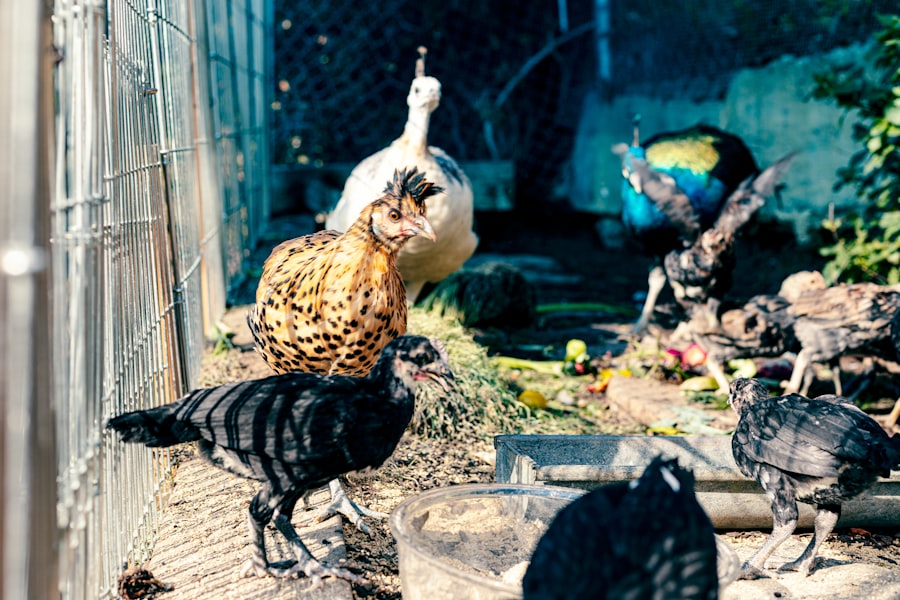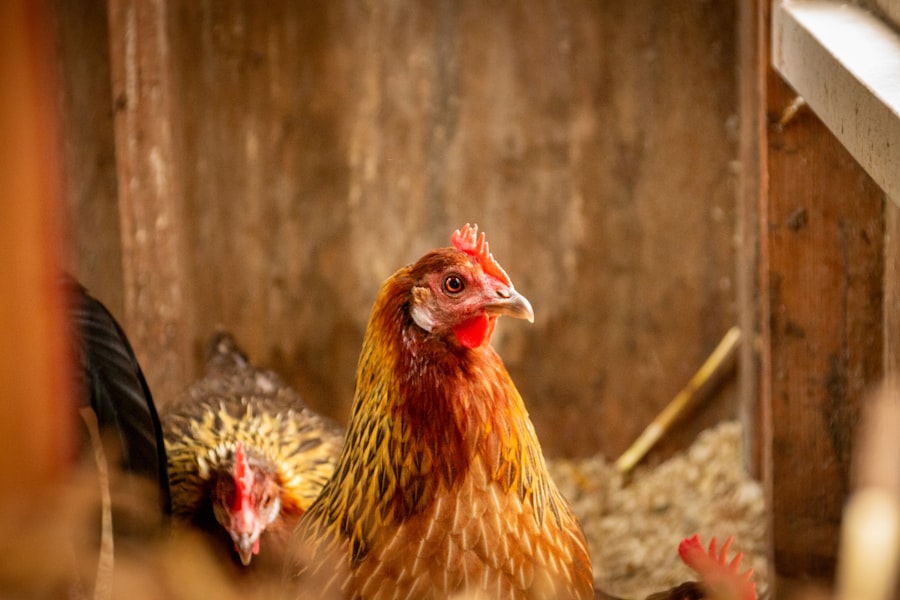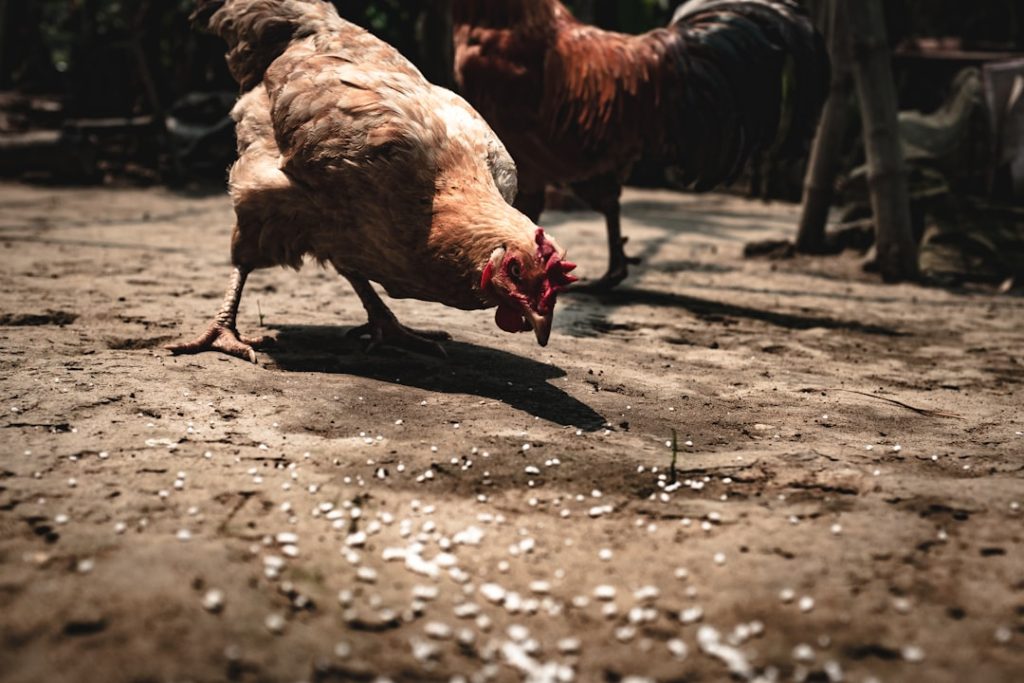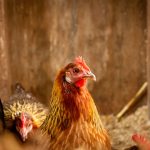Maintaining dry conditions for chickens is essential for their health and welfare. Wet environments can cause numerous problems for chickens, including respiratory diseases, feather damage, and mortality. Exposure to damp conditions increases the risk of respiratory infections like bronchitis and pneumonia.
Wet feathers also reduce insulation, making chickens more susceptible to temperature changes and stress. Damp environments promote the growth of harmful bacteria and fungi, leading to various diseases in chickens. Wet litter and bedding attract pests such as mites and flies, further compromising flock health.
Therefore, keeping chickens dry is crucial for preventing these health issues and ensuring their overall well-being. To maintain dry conditions for chickens, provide adequate shelter, appropriate bedding and litter, regular cleaning and maintenance, and proper management of water sources. Implementing these measures creates a healthy and comfortable environment for the flock, reducing the risk of health problems associated with damp conditions.
Table of Contents
Key Takeaways
- Keeping chickens dry is crucial for their health and well-being, as wet conditions can lead to various health issues and discomfort.
- Providing adequate shelter is essential to protect chickens from rain, wind, and extreme temperatures, ensuring their comfort and safety.
- Proper bedding and litter help absorb moisture and provide insulation, keeping the coop dry and comfortable for the chickens.
- Regular cleaning and maintenance of the coop and bedding are necessary to prevent moisture buildup and the growth of bacteria and mold.
- Managing water sources and utilizing natural and artificial drainage systems can help prevent water from accumulating in the coop area.
- Monitoring weather conditions is important to anticipate and prevent potential moisture-related problems, such as leaks or flooding in the coop.
Providing Adequate Shelter
Designing a Well-Constructed Coop
A well-constructed coop or housing structure is crucial in keeping chickens dry. It should be designed to provide proper ventilation while keeping out moisture, protecting chickens from rain, snow, and other environmental elements that can lead to dampness. This can be achieved through the use of windows, vents, and proper insulation to regulate humidity levels inside the coop.
Maintenance and Inspections
Regular inspections should be conducted to identify any potential areas of concern and address them promptly. It is essential to ensure that the roof of the coop is in good condition and free from leaks. By doing so, chicken owners can prevent their flock from being exposed to damp conditions that can lead to health issues.
Outdoor Shelters and Runs
In addition to the coop, providing outdoor shelters such as covered runs or shelters is vital for chickens to seek refuge from inclement weather. These shelters should be strategically placed to provide protection from wind and rain while allowing chickens to have access to fresh air and natural light.
Importance of Dry Shelter for Chicken Health
Providing a dry and comfortable shelter for chickens is essential for their overall health and well-being. By providing adequate shelter, chicken owners can help prevent their flock from being exposed to damp conditions that can lead to health issues.
Proper Bedding and Litter

Proper bedding and litter play a crucial role in keeping chickens dry and comfortable. The choice of bedding material is important in maintaining a dry environment for the flock. Materials such as straw, wood shavings, or shredded paper can be used as bedding to provide insulation and absorb moisture.
It is important to regularly monitor the bedding and replace it as needed to prevent the accumulation of moisture. Furthermore, proper litter management is essential in maintaining a dry environment for chickens. Litter should be regularly turned over to aerate it and promote drying.
Additionally, adding absorbent materials such as diatomaceous earth or sand can help control moisture levels in the litter. By maintaining proper bedding and litter, chicken owners can create a comfortable and dry environment for their flock, reducing the risk of health issues associated with damp conditions. Regular cleaning and maintenance are essential in preventing the buildup of moisture in the coop and run areas.
This includes removing soiled bedding, droppings, and spilled feed on a regular basis. By keeping the living areas clean and dry, chicken owners can help prevent the growth of harmful bacteria and fungi that thrive in damp conditions. Additionally, regular maintenance of the coop and run areas can help identify any potential issues such as leaks or drainage problems that need to be addressed to maintain a dry environment for the flock.
Regular Cleaning and Maintenance
Regular cleaning and maintenance are essential in preventing the buildup of moisture in the coop and run areas. This includes removing soiled bedding, droppings, and spilled feed on a regular basis. By keeping the living areas clean and dry, chicken owners can help prevent the growth of harmful bacteria and fungi that thrive in damp conditions.
Additionally, regular maintenance of the coop and run areas can help identify any potential issues such as leaks or drainage problems that need to be addressed to maintain a dry environment for the flock. In addition to regular cleaning, it is important to conduct thorough inspections of the coop and run areas to identify any potential areas of concern. This includes checking for leaks in the roof or walls, ensuring that windows and vents are functioning properly, and inspecting the overall structural integrity of the housing.
Addressing any issues promptly can help prevent moisture from entering the living areas and ensure that chickens are kept dry and comfortable. Furthermore, proper ventilation is essential in maintaining a dry environment for chickens. Good airflow helps regulate humidity levels inside the coop and prevents the buildup of moisture.
This can be achieved through the use of windows, vents, and fans to promote air circulation. Proper ventilation not only helps keep chickens dry but also contributes to overall air quality inside the coop, reducing the risk of respiratory issues.
Managing Water Sources
Effective management of water sources is crucial in preventing damp conditions in the chicken coop and run areas. This includes ensuring that waterers are properly maintained to prevent leaks or spills that can lead to wet bedding and litter. Additionally, waterers should be strategically placed to minimize the risk of water splashing onto the ground or surrounding areas.
It is also important to regularly monitor water sources for any signs of contamination or buildup of algae, which can contribute to moisture-related issues. Regular cleaning and maintenance of waterers are essential in ensuring that chickens have access to clean water while also preventing excess moisture from accumulating in the living areas. Furthermore, providing adequate drainage around water sources can help prevent water from pooling in the coop or run areas.
This includes ensuring that gutters are clear of debris and directing runoff away from the living areas. By effectively managing water sources, chicken owners can help maintain a dry environment for their flock, reducing the risk of health issues associated with damp conditions.
Utilizing Natural and Artificial Drainage

Preventing Moisture Buildup with Grading and Gutters
Utilizing natural and artificial drainage methods can help prevent moisture buildup in the chicken coop and run areas. This includes ensuring that the ground around the coop is properly graded to promote runoff away from the living areas. Additionally, installing gutters and downspouts can help direct rainwater away from the coop to prevent water from seeping into the structure.
Addressing Drainage Issues and Pooling Water
In addition to managing surface water, it is important to address any potential drainage issues that may contribute to damp conditions. This includes identifying areas where water may pool or collect and implementing measures such as French drains or swales to redirect water away from the living areas. By effectively managing drainage, chicken owners can help maintain a dry environment for their flock, reducing the risk of health issues associated with damp conditions.
Utilizing Natural Features for Additional Protection
Furthermore, utilizing natural features such as trees or shrubs can provide additional protection from wind and rain while also helping absorb excess moisture from the surrounding environment. Planting vegetation strategically around the coop and run areas can help create a more comfortable and dry environment for chickens while also contributing to overall environmental sustainability.
Monitoring Weather Conditions
Monitoring weather conditions is essential in maintaining a dry environment for chickens. By staying informed about upcoming weather patterns, chicken owners can take proactive measures to protect their flock from damp conditions. This includes providing additional shelter during periods of heavy rain or snowfall and ensuring that drainage systems are functioning properly.
Additionally, monitoring humidity levels inside the coop can help identify any potential issues with moisture buildup. This can be achieved through the use of hygrometers or by simply observing condensation levels on windows or walls. By staying vigilant about weather conditions, chicken owners can take proactive measures to maintain a dry environment for their flock, reducing the risk of health issues associated with damp conditions.
In conclusion, keeping chickens dry is essential for their health and well-being. By providing adequate shelter, proper bedding and litter, regular cleaning and maintenance, effective management of water sources, utilizing natural and artificial drainage methods, and monitoring weather conditions, chicken owners can create a healthy and comfortable environment for their flock. By implementing these measures, chicken owners can reduce the risk of health problems associated with damp conditions while promoting the overall well-being of their flock.
If you’re looking for tips on how to keep chickens dry, you might also be interested in learning about the importance of a well-designed chicken coop. Check out this article on chicken coop portage to discover how the right coop can help protect your chickens from the elements and keep them dry and comfortable.
FAQs
What are the benefits of keeping chickens dry?
Keeping chickens dry helps to prevent health issues such as respiratory infections and feather mites. It also helps to maintain the overall well-being and comfort of the chickens.
How can I keep my chicken coop dry?
To keep your chicken coop dry, ensure proper ventilation, use moisture-absorbing bedding such as straw or wood shavings, and regularly clean and maintain the coop to prevent moisture buildup.
What are some tips for keeping chickens dry in wet weather?
During wet weather, provide shelter for your chickens to keep them dry, use waterproof covers for the coop and run, and consider adding drainage systems to prevent water accumulation.
What should I do if my chickens get wet?
If your chickens get wet, provide a warm and dry environment for them to dry off. You can also gently towel-dry them if necessary, and ensure they have access to dry bedding.
Are there specific breeds of chickens that are more resistant to wet conditions?
Some chicken breeds, such as Orpingtons and Sussex, are known for their resistance to wet conditions due to their dense feathering and hardy nature. However, all chickens can benefit from proper care to keep them dry.
Meet Walter, the feathered-friend fanatic of Florida! Nestled in the sunshine state, Walter struts through life with his feathered companions, clucking his way to happiness. With a coop that’s fancier than a five-star hotel, he’s the Don Juan of the chicken world. When he’s not teaching his hens to do the cha-cha, you’ll find him in a heated debate with his prized rooster, Sir Clucks-a-Lot. Walter’s poultry passion is no yolk; he’s the sunny-side-up guy you never knew you needed in your flock of friends!







